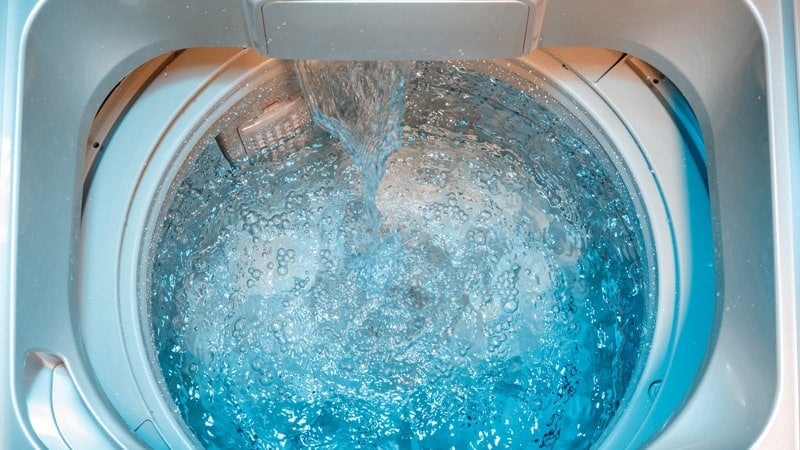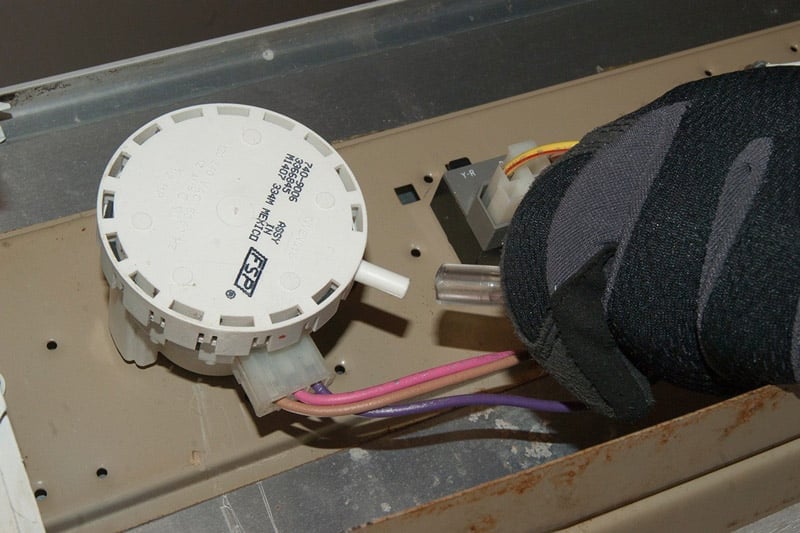Mvwx700xw1 Washer Continuous Fill and Drain
Unless you have a particular fondness for mopping your laundry room floor, a washer that won't stop filling with water is a major inconvenience. There are a few reasons this problem may be happening, but, luckily, the fixes are easy.
Before you have to get the mop out again, let's get to the bottom of your washing machine woes. What exactly is it causing it to fill up and how can you fix it?
Washing Machine Mechanics Basics
Every washing machine is different in little ways, of course, but the basic mechanics are the same no matter what brand you opt for. Knowing how the appliance works can help you repair it.
When it comes to water issues, there are a few components that are typically at fault. Let's review what these parts do and where they can be located.
Water Inlet Control Valve
You probably know your washing machine is attached to two different hoses. These two hoses bring in hot and cold water, depending on what the wash calls for. You can think of it as the bouncers or security at the door – water doesn't get in unless the valve says so.
The water inlet control valve is the component of the machine that the hoses connect to. It has two threaded ports that the hoses screw into. It receives its orders from the water level switch, which we'll get to in the next section.
If your washer keeps filling up with water, the issue could likely be due to the water inlet control valve. It does control the water flow, after all. The water inlet control valve is found on the back of the washing machine.
Water Level Switch
While the control valve lets in water, the water level switch lets the valve know when the tub has enough for the job. If the water inlet control valve is the bouncer, the water level switch is the manager who radios the bouncer to say the place is at maximum capacity.
There are different types of water level switches. Most of today's washing machines utilize a pressostat, or a pressure switch. The switch is connected to a hose that leads to the body of the washer. As water fills, air moves through the hose towards the switch, applying pressure. When enough pressure is applied, the switch sends the order to turn off the water.
You will need to consult your machine's manual to locate the switch in your washer. Most likely, it will be found under the top panel of a front-loading machine, for instance.

4 Causes & Fixes
Check the Water Inlet Control Valve for Clogs
If you haven't disconnected the water hoses yet, now is the time. After removing the hoses, check the valve's ports for any clogs. This can be done visually; using a flashlight, look into the ports and look for any debris.
Inside the ports, you should see a small screen. These screens are the ports filters. If they look dirty, you'll need to clean them.
Before you even touch a screen, heed this warning: these screens are delicate and cannot be replaced. Damaging a screen requires replacing the entire control valve.
Using needle nose pliers, remove that screen as gently as possible. Place the screen in your palm and try to brush away any sediment you see. If it's stubborn, you can try a small brush, like a toothbrush.
If the dirt isn't going anywhere, you can soak the screens in a mixture of water and vinegar. After a short time, you should be able to brush away the debris. Once the screens are clean to your satisfaction, replace them in the ports.
Check the Water Inlet Control Valve's Solenoids
Checking the solenoids is a little more complicated than cleaning the screens. To make a long story short, a solenoid is a name for a valve powered by electricity. If your washing machine is having water issues, your valve may have electricity issues.
To test the power of the valve, you'll need a device called a multimeter. It's a device that measures electricity. You can purchase a multimeter at any hardware store. Most are less than $20.
To gauge the valve's power, remove it from your washing machine. Using the multimeter, touch the two test prods to the coil inside the valve's terminals. If you aren't sure how to use a multimeter, YouTube videos, make it easy.
When you test the solenoid, the multimeter should detect a level of resistance. If it gives a reading of zero, your water inlet control valve has failed and needs to be replaced.
To replace the valve, consult the owner's manual for your machine so you can be sure to purchase the proper model for your machine.
Test the Water Level Switch
If the water inlet control valve is in good working order, turn your attention to the water level switch. In the description of the component above, it was mentioned that the switch is attached to a hose. That hose needs to be in good working order to detect the water level.
Once you've located the switch, remove it from the hose. Take a good look at the hose. Any holes or tears will prevent the air in the hose from ever reaching the switch. If the hose is damaged, it will need to be replaced.
No holes? Great! Now, check the inside of the hose. Is it clogged? Any clog would interfere with an accurate reading of the water level. The hose won't need to be replaced over a clog. Cleaning it out should do the trick.
If the hose passes the visual inspection, you may have an electrical issue. If you still have the multimeter from the last step, you'll want to test the level of resistance in this component as well. Like with the valve, if the readings indicate no resistance, it will need to be replaced.

Check Your Water Pressure
This issue doesn't signify an issue with the appliance itself. An overfilling washing machine could mean a water pressure issue in your home overall.
The motion of water is called flow. Water naturally flows downward. Water pressure, or the weight of water moving downward, determines how fast it goes. Simply put, the heavier water is on top, the faster it will all flow.
You likely know the status of your home's water pressure. When you get a shower, is the water pressure weak or strong? Few people enjoy a shower with low water pressure! Unfortunately, washers aren't crazy about low water pressure either.
Decades ago, washing machines depended on a motor that switched on at a certain water level. When the level was achieved, on went the motor.
Today, your washing machine is a portrait of efficiency and convenience – if the water pressure is just right. Your appliance is full of software that keeps it in working order. One such program keeps track of how long the water takes to fill in the tub. If the water pressure is too low and takes too long to fill that basin, the software will abort the mission, so to speak.
For an accurate reading of your home's water pressure, you can purchase a water pressure gauge. It threads onto your outdoor hose for its reading. If you get anything below 40 pressure per square inch (PSI), you have low water pressure.
How do you increase your home's water pressure? Unfortunately, this step isn't a quick fix. You can buy a water booster system, which is a pump that can increase water pressure. They are a pricey option and installation shouldn't usually be done without professional help.
Conclusion
When it comes to washing clothes, some water is necessary. However, when that water starts to cause a filling issue, your washing machine needs attention. Ideally, it will be a quick fix like replacing a switch or a valve. You'll be back to cleaning clothes in no time.
Is any other appliance in your house acting up? Maybe your dehumidifier won't drain properly? We can help.
Source: https://applianceanalysts.com/washer-filling-with-water/
0 Response to "Mvwx700xw1 Washer Continuous Fill and Drain"
Post a Comment